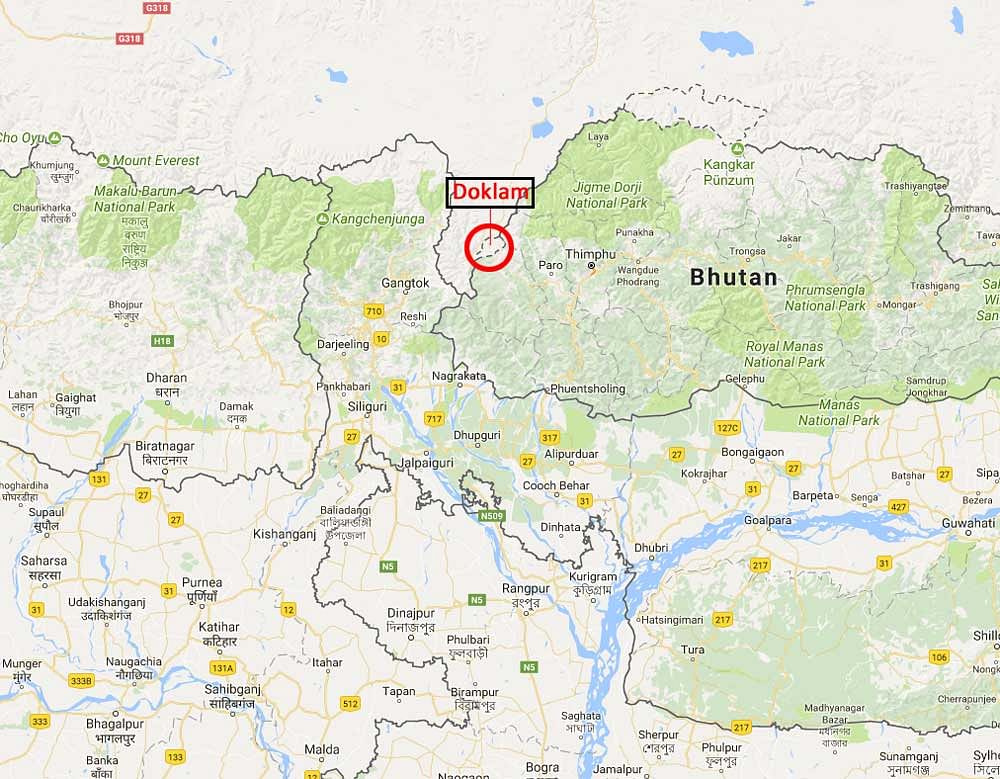Last Updated IST

Doklam along the disputed border between Bhutan and China has been the scene of the face-off between the soldiers of Indian Army and Chinese People's Liberation Army since June 18. Google Maps
The records of Bhutanese Parliament's proceedings disprove Beijing's recent claim that Thimphu has accepted Doklam – the scene of the current India-China military face-off – as a part of the communist country.
Though a senior diplomat of the Ministry of Foreign Affairs of Chinese Government of late claimed that Thimphu accepted Doklam to be a part of China, the records of the proceedings of both Houses of Bhutanese Parliament do not support it. The records rather make it clear that Thimphu has been consistently referring to Doklam as one of the “disputed areas” between Bhutan and China and has never given up its claim on it.
Doklam along the disputed border between Bhutan and China has been the scene of the face-off between the soldiers of Indian Army and Chinese People's Liberation Army since June 18.
Damcho Dorjee, Foreign Minister of Bhutan, told the country's National Council on November 25, 2016 that Doklam was among the disputed areas between the Himalayan Kingdom and China. He referred to Doklam as a disputed area between China and Bhutan during the 18th session of the upper House of Bhutanese Parliament. He was responding to a question from Tshering Dorjee, a member of the National Council from Haa districrt in westerm Bhutan, according to the records of Bhutanese Parliament available with the DH.
Dorjee made the statement four months after Bhutan and China had held the last of the 24 rounds of negotiations they so far had to resolve the dispute over boundary. As the two nations did not hold any further negotiation on the boundary row after the last in August 2016, it is unlikely that Bhutan reached a breakthrough with China on the dispute over Doklam, a source in New Delhi said, dismissing the claim made by Beijing.
Deputy Director General of the Department of Boundary and Ocean Affairs of the Chinese Government's Ministry of Foreign Affairs, Wang Wenli, recently claimed that Thimphu had conveyed to Beijing through diplomatic channel that it considered Doklam as a territory of China, not Bhutan. The Chinese diplomat made the claim while interacting with some Indian journalists in Beijing.
But, according to Bhutanese Parliament's records, Thimphu consistently maintained that it had territorial dispute with Beijing over Doklam. Pema Wangchhuk, the then Secretary of International Boundaries of Bhutanese Government, told the members of the country's National Council in November, 2009 that Doklam was one of the disputed areas between Bhutan and China in the western region of the kingdom. Wangchhuk was Thimphu's chief interlocutor for boundary negotiation with Beijing for many years till his death in November 2016.
In his annual “state of the nation” address to Bhutanese Parliement in June 2015; Tshering Tobgay, Prime Minister of the country, too referred to Doklam as one of the “disputed areas” along Bhutan-China border he had been visiting during the previous months.
The soldiers of Indian Army on June 18 went to Doklam and stopped Chinese PLA personnel, who had on June 16 started building the road two days back brushing aside protests by the Royal Bhutanese Army border-guards deployed in a nearby post. The Ministry of Foreign Affairs of Bhutanese Government on June 29 said that Chinese People's Liberation Army's move to build a road in Doklam had been a “direct violation” of the agreements between Thimphu and Beijing to maintain peace and tranquillity along the disputed boundary between the two nations pending a final settlement of the row. A day later, New Delhi said that Indian Army soldiers had gone to Doklam in western Bhutan in coordination with the Royal Government of Bhutan to stop the Chinese PLA personnel from building the road.
New Delhi has been arguing that it had to intervene to stop construction of the road by the Chinese PLA, as it would have unilaterally changed the status quo on India-China-Bhutan tri-junction boundary point and would have “serious security implications” for India.
Beijing, however, has been insisting that Doklam is a part of China and Indian Army had trespassed into its territory. China also claimed that it had no dispute with Bhutan over Doklam, only a difference in perception over alignment of the boundary.
Bhutan and China started boundary negotiations in 1984 and had the 24th round in August 2016. The records of Bhutanese Parliament make it clear that Thimphu has been consistently staking claim on Doklam at least since 2000.
“Boundary talks are ongoing between Bhutan and China and we have written agreements of 1988 and 1998 stating that the two sides agree to maintain peace and tranquility in their border areas pending a final settlement on the boundary question, and to maintain status quo on the boundary as before March 1959,” the Ministry of Foreign Affairs of Bhutan Government said in a statement issued on June 29. “The agreements also state that the two sides will refrain from taking unilateral action, or use of force, to change the status quo of the boundary,” it added.
Though a senior diplomat of the Ministry of Foreign Affairs of Chinese Government of late claimed that Thimphu accepted Doklam to be a part of China, the records of the proceedings of both Houses of Bhutanese Parliament do not support it. The records rather make it clear that Thimphu has been consistently referring to Doklam as one of the “disputed areas” between Bhutan and China and has never given up its claim on it.
Doklam along the disputed border between Bhutan and China has been the scene of the face-off between the soldiers of Indian Army and Chinese People's Liberation Army since June 18.
Damcho Dorjee, Foreign Minister of Bhutan, told the country's National Council on November 25, 2016 that Doklam was among the disputed areas between the Himalayan Kingdom and China. He referred to Doklam as a disputed area between China and Bhutan during the 18th session of the upper House of Bhutanese Parliament. He was responding to a question from Tshering Dorjee, a member of the National Council from Haa districrt in westerm Bhutan, according to the records of Bhutanese Parliament available with the DH.
Dorjee made the statement four months after Bhutan and China had held the last of the 24 rounds of negotiations they so far had to resolve the dispute over boundary. As the two nations did not hold any further negotiation on the boundary row after the last in August 2016, it is unlikely that Bhutan reached a breakthrough with China on the dispute over Doklam, a source in New Delhi said, dismissing the claim made by Beijing.
Deputy Director General of the Department of Boundary and Ocean Affairs of the Chinese Government's Ministry of Foreign Affairs, Wang Wenli, recently claimed that Thimphu had conveyed to Beijing through diplomatic channel that it considered Doklam as a territory of China, not Bhutan. The Chinese diplomat made the claim while interacting with some Indian journalists in Beijing.
But, according to Bhutanese Parliament's records, Thimphu consistently maintained that it had territorial dispute with Beijing over Doklam. Pema Wangchhuk, the then Secretary of International Boundaries of Bhutanese Government, told the members of the country's National Council in November, 2009 that Doklam was one of the disputed areas between Bhutan and China in the western region of the kingdom. Wangchhuk was Thimphu's chief interlocutor for boundary negotiation with Beijing for many years till his death in November 2016.
In his annual “state of the nation” address to Bhutanese Parliement in June 2015; Tshering Tobgay, Prime Minister of the country, too referred to Doklam as one of the “disputed areas” along Bhutan-China border he had been visiting during the previous months.
The soldiers of Indian Army on June 18 went to Doklam and stopped Chinese PLA personnel, who had on June 16 started building the road two days back brushing aside protests by the Royal Bhutanese Army border-guards deployed in a nearby post. The Ministry of Foreign Affairs of Bhutanese Government on June 29 said that Chinese People's Liberation Army's move to build a road in Doklam had been a “direct violation” of the agreements between Thimphu and Beijing to maintain peace and tranquillity along the disputed boundary between the two nations pending a final settlement of the row. A day later, New Delhi said that Indian Army soldiers had gone to Doklam in western Bhutan in coordination with the Royal Government of Bhutan to stop the Chinese PLA personnel from building the road.
New Delhi has been arguing that it had to intervene to stop construction of the road by the Chinese PLA, as it would have unilaterally changed the status quo on India-China-Bhutan tri-junction boundary point and would have “serious security implications” for India.
Beijing, however, has been insisting that Doklam is a part of China and Indian Army had trespassed into its territory. China also claimed that it had no dispute with Bhutan over Doklam, only a difference in perception over alignment of the boundary.
Bhutan and China started boundary negotiations in 1984 and had the 24th round in August 2016. The records of Bhutanese Parliament make it clear that Thimphu has been consistently staking claim on Doklam at least since 2000.
“Boundary talks are ongoing between Bhutan and China and we have written agreements of 1988 and 1998 stating that the two sides agree to maintain peace and tranquility in their border areas pending a final settlement on the boundary question, and to maintain status quo on the boundary as before March 1959,” the Ministry of Foreign Affairs of Bhutan Government said in a statement issued on June 29. “The agreements also state that the two sides will refrain from taking unilateral action, or use of force, to change the status quo of the boundary,” it added.
Deccan Herald is on WhatsApp Channels| Join now for Breaking News & Editor's Picks
